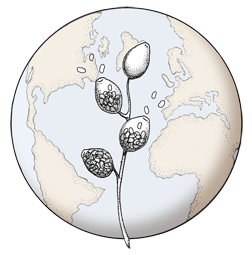References
Current and projected global distribution of Phytophthora cinnamomi, one of the world's worst plant pathogens. Global Change Biology [Internet]. 2016 . Available from: http://dx.doi.org/10.1111/gcb.13492
. Re-evaluation of Phytophthora species isolated during 30 years of vegetation health surveys in western Australia using molecular techniques. Plant Disease. 2009 ;93(3):215 - 223.
. Report of the imperial mycologist, 1918–1919. Science Report Institute Pusa. 0 :82 pp.
. Bud rot of coconut and other palms. Report of Imperial Botanical Conference. 1924 :145-147.
. Phytophthora cinnamomi and Australia’s biodiversity: impacts, predictions and progress towards control. Australian Journal of Botany [Internet]. 2008 ;56:279–310. Available from: http://dx.doi.org/10.1071/BT07159
. Littleleaf disease of shortleaf and loblolly pines. 1954 :41 pages.
. The occurrence of Phytophthora cinnamomi in the soil under pine stands in the southeast. Phytopathology. 1951 ;41:742-746.
. Developing a taxonomic identification system of Phytophthora species based on microsatellites. Revista Iberoamericana de Micologia [Internet]. 2012 ;In press:-. Available from: http://www.sciencedirect.com/science/article/pii/S1130140612001106
. Metabarcoding and development of new Real-time specific assays reveal Phytophthora species diversity in Holm Oak forests in eastern Spain. Plant Pathology [Internet]. 2017 ;66:115–123. Available from: http://doi.wiley.com/10.1111/ppa.12541
. Phytophthora cambivora causing ink disease of sweet chestnut recorded in the Czech Republic. Czech Mycol. [Internet]. 2008 ;60:265–274. Available from: http://www.natur.cuni.cz/cvsm/CM60210.pdf
. Phytophthora ramorum in England and Wales: which environmental variables predict county disease incidence?. Forest Pathology [Internet]. 2011 :no–no. Available from: http://dx.doi.org/10.1111/j.1439-0329.2011.00735.x
. Change of Mating Type in an EU1 Lineage Isolate of Phytophthora ramorum. Journal of Phytopathology [Internet]. 2013 :n/a - n/a. Available from: http://onlinelibrary.wiley.com/doi/10.1111/jph.12150/abstract
. Effect of temperature and bacteria on sporulation of Phytophthora alni in river water. Commun Agric Appl Biol Sci. [Internet]. 2006 ;71:873–80. Available from: http://www.ncbi.nlm.nih.gov/pubmed/17390834
. Assessment of inoculation methods for screening black alder resistance to Phytophthora × alni. Plant Pathology [Internet]. 2016 ;65(3):441 - 450. Available from: http://doi.wiley.com/10.1111/ppa.2016.65.issue-3http://doi.wiley.com/10.1111/ppa.12418http://api.wiley.com/onlinelibrary/tdm/v1/articles/10.1111%2Fppa.12418
. Symptoms and Phytophthora spp. associated with root rot and stem canker of noble fir Christmas trees in the Pacific Northwest. Plant disease [Internet]. 1995 ;79:290–293. Available from: http://www.apsnet.org/publications/PlantDisease/BackIssues/Documents/1995Abstracts/PD_79_290.htm
. Membrane-based oligonucleotide array developed from multiple markers for the detection of many Phytophthora species. Phytopathology. 2013 ;103(1):43 - 54.
. Detection of mRNA by reverse-transcription PCR as an indicator of viability in Phytophthora ramorum. Forest Pathology [Internet]. 2012 ;42:14–21. Available from: http://dx.doi.org/10.1111/j.1439-0329.2011.00717.x
. First report of Phytophthora gonapodyides causing stem canker on European beech (Fagus sylvatica) in Southern Sweden. Plant Disease [Internet]. 2016 . Available from: http://apsjournals.apsnet.org/doi/10.1094/PDIS-04-16-0468-PDN
. Promise and Pitfalls of Endemic Resistance for Cultural Resources Threatened by Phytophthora ramorum. Phytopathology [Internet]. 2019 ;109(5):760 - 769. Available from: https://apsjournals.apsnet.org/doi/pdf/10.1094/PHYTO-04-18-0142-R
. Phytophthora siskiyouensis on alders in southern California: an update. 58th Annual Meeting of the California Forest Pest Council, What’s Ailing California’s Forests? 2009 :pg 46-47.
. The long-term survival of Phytophthora cinnamomi in mature Banksia grandis killed by the pathogen. Forest Pathology [Internet]. 2012 ;42:28–36. Available from: http://dx.doi.org/10.1111/j.1439-0329.2011.00718.x
. Genetic diversity of European populations of the oak fine-root pathogen Phytophthora quercina. Forest Pathology. 2005 ;35(1):57 - 70.
. Phylogenetic analysis of Phytophthora species based on ITS1 and ITS2 sequences of the ribosomal RNA gene repeat. Mycological Research [Internet]. 1997 ;101(6):667 - 677. Available from: http://linkinghub.elsevier.com/retrieve/pii/S0953756208604888
. A molecular phylogeny of Phytophthora and related Oomycetes. Fungal Genetics and Biology [Internet]. 2000 ;30:17-32. Available from: http://www.sciencedirect.com/science/article/B6WFV-45FC03G-1G/2/1cb8ec25d08dae3a16f56e74cd92e99e
. First report of Phytophthora gonapodyides involved in the decline of Quercus ilex in xeric conditions in Spain. New Disease Reports. 2010 ;22:33.



 ]
]